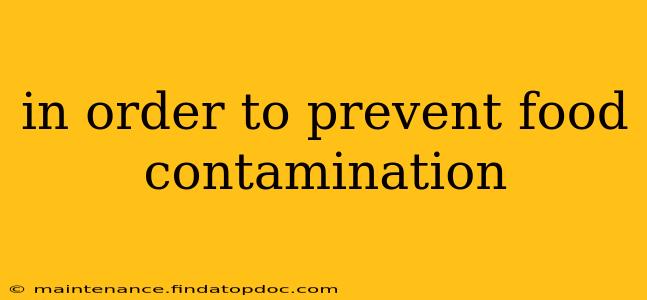Food contamination is a serious concern, impacting public health and potentially causing illness or even death. Understanding how to prevent food contamination is crucial for everyone, from home cooks to large-scale food manufacturers. This comprehensive guide explores various methods and best practices to ensure food safety and minimize the risk of contamination.
What are the Main Types of Food Contamination?
Food contamination can be broadly categorized into three main types:
-
Biological Contamination: This involves the presence of harmful microorganisms like bacteria (e.g., Salmonella, E. coli), viruses (e.g., norovirus, hepatitis A), parasites (e.g., Toxoplasma gondii), and fungi (e.g., molds). These can cause foodborne illnesses.
-
Chemical Contamination: This refers to the presence of harmful chemicals in food, such as pesticides, cleaning agents, heavy metals, or toxins produced by certain plants or algae. Improper food storage or handling can also lead to chemical contamination.
-
Physical Contamination: This involves the presence of foreign objects in food, such as glass shards, metal pieces, hair, insects, or stones. These can cause injury or illness.
How to Prevent Biological Contamination?
Preventing biological contamination is paramount. Here’s how:
Maintaining Proper Hygiene:
-
Handwashing: Wash your hands thoroughly with soap and water before, during, and after handling food. This is arguably the single most important step in preventing foodborne illness.
-
Cleaning Surfaces: Regularly clean and sanitize all surfaces that come into contact with food, including countertops, cutting boards, utensils, and sinks.
-
Food Storage: Store food at the correct temperature. Refrigerate perishable items promptly to slow the growth of bacteria. Freeze foods for longer-term storage.
Safe Food Handling Practices:
-
Cook Food Thoroughly: Ensure food is cooked to the appropriate internal temperature to kill harmful microorganisms. Use a food thermometer to verify.
-
Avoid Cross-Contamination: Prevent cross-contamination by separating raw meat, poultry, and seafood from ready-to-eat foods. Use separate cutting boards and utensils.
-
Thaw Food Safely: Thaw frozen food safely in the refrigerator, under cold running water, or in the microwave. Never thaw food at room temperature.
How to Prevent Chemical Contamination?
Preventing chemical contamination involves careful selection and handling of food and cleaning products:
Source Selection:
-
Choose Safe Ingredients: Buy food from reputable sources that adhere to food safety standards. Be mindful of pesticide residue on fruits and vegetables; consider washing thoroughly or peeling.
-
Proper Storage of Chemicals: Store cleaning supplies and pesticides separately from food and away from children's reach.
Cleaning Practices:
-
Use Food-Safe Cleaning Products: Use cleaning products specifically designed for food contact surfaces and rinse thoroughly before handling food.
-
Avoid Mixing Cleaning Agents: Never mix different cleaning agents, as this can create dangerous chemical reactions.
How to Prevent Physical Contamination?
Preventing physical contamination requires careful attention to detail throughout the food preparation process:
Food Preparation Practices:
-
Inspect Ingredients: Carefully inspect all ingredients for any foreign objects before using them.
-
Protect Food from Pests: Store food in airtight containers to prevent infestation by insects or rodents.
-
Proper Handling of Equipment: Regularly check equipment (e.g., blenders, meat grinders) for any damage or loose parts that could contaminate food.
What are the Signs of Food Poisoning?
Symptoms of food poisoning vary depending on the type of contaminant, but commonly include nausea, vomiting, diarrhea, abdominal cramps, fever, and headache. If you suspect food poisoning, seek medical attention promptly.
How can I minimize the risk of food contamination when eating out?
When eating out, choose restaurants with a good reputation for hygiene and cleanliness. Observe the staff’s handling practices. If you have any concerns about food safety, don’t hesitate to ask questions.
What are the best practices for preventing food contamination in food processing plants?
Food processing plants must adhere to stringent food safety regulations and employ rigorous quality control measures throughout the entire process, from sourcing ingredients to packaging the finished product. This includes regular inspections, employee training, and sophisticated equipment. Hazard Analysis and Critical Control Points (HACCP) is a widely adopted system for managing food safety risks.
This guide provides a solid foundation for preventing food contamination. Remember, food safety is a collective responsibility, and by following these best practices, you can significantly reduce your risk of foodborne illnesses. Always prioritize safe food handling and hygiene to ensure the health and well-being of yourself and others.
